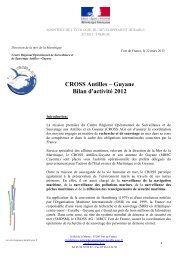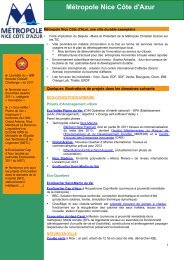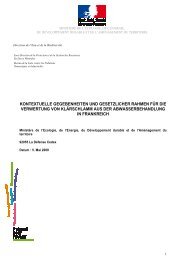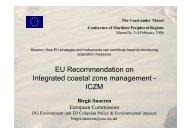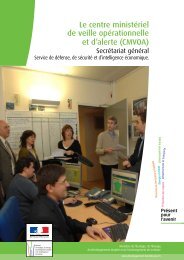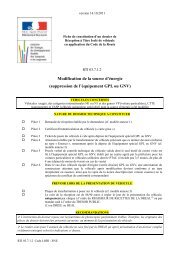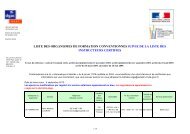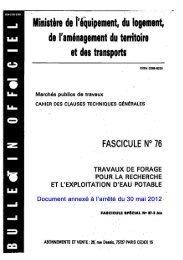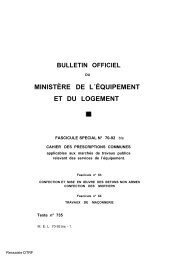Aviation Civile
Aviation Civile
Aviation Civile
Create successful ePaper yourself
Turn your PDF publications into a flip-book with our unique Google optimized e-Paper software.
© Dassault<br />
26 AERoNAuTICS INDuSTRy<br />
27<br />
Interface Two events illustrate the high technology of Dassault <strong>Aviation</strong><br />
Falcon business aircraft: the EASy II cockpit and the launch of the Falcon 2000S.<br />
Falcon “eASy II”,<br />
compatible with EGNOS<br />
In 2003, Dassault <strong>Aviation</strong> installed<br />
the “EASy” cockpit in its Falcon aircraft,<br />
a real revolution in the field of<br />
man-machine interfaces. Resulting<br />
from ten years work, it represents<br />
real progress in terms of ergonomics,<br />
coordinated crew work and safety.<br />
EASy has four large screens arranged<br />
in a T in front of the pilots. It displays<br />
all of the information they need when<br />
they need it: flight parameters, states<br />
of systems, charts and aircraft trajectory,<br />
weather forecasts, check list, etc.<br />
In an emergency the problem—and its<br />
solution—are automatically displayed<br />
on the screen.<br />
The EASy cockpit means easy, intuitive<br />
and safe flight management with scrolling<br />
menus and the selection of functions<br />
using a “track ball”, the equivalent of a<br />
computer mouse. Pilots have a continuous<br />
and instantaneous overall view of<br />
the aircraft’s current and future situation<br />
in its environment. The advantage<br />
is that the workload is lightened which<br />
means greater safety.<br />
Today, on the strength of the experience<br />
of around 400 Falcon operators<br />
– and to take account of changes in air<br />
navigation regulations – Dassault <strong>Aviation</strong><br />
is further improving the design<br />
with an EASy II version. It includes the<br />
latest technologies featured with new<br />
options and functionalities. For example,<br />
a synthetic vision system that provides<br />
a digital representation of the external<br />
environment so that the terrain can be<br />
seen as in full daylight, even in very poor<br />
visibility.<br />
The EASy II cockpit will be offered<br />
as a standard equipment on board Falcon<br />
900LX aircraft immediately after<br />
its certification, expected at the end of<br />
May 2011, then at the end of 2012 for Falcon<br />
2000LX and Falcon 7X aircraft.<br />
One of the advantages of the EASy II<br />
cockpit is its total compatibility with the<br />
new navigation systems, in particular<br />
the European EGNOS 1 . This is why Dassault<br />
was among the first operators to<br />
experiment with its signal and measure<br />
the benefits. In February 2011, when<br />
the European service opened, seven LPV 2<br />
type instrument approaches—i.e. down<br />
to 80 m, the minimum descent height<br />
authorised—were made at the Pau<br />
Pyrénées airport by a Falcon 900LX.<br />
régis noyé<br />
1/ European Geostationary Navigation Overlay<br />
Service (read <strong>Aviation</strong> <strong>Civile</strong> No.357).<br />
2/ Localizer Performance with Vertical Guidance.<br />
30 CM ACCuRACy<br />
“We have been able to confirm<br />
the reliability and high accuracy, right up<br />
to landing, of the new EGNOS signal,<br />
to about 30 cm, measured as the wheels<br />
touched the runway, says Jean-Louis<br />
Dumas, test pilot. LPV2 approaches<br />
considerably improve the accessibility<br />
of a large number of secondary airports<br />
with little or poor equipment. The EGNOS<br />
system will offer operators more direct<br />
routes and a greater flexibility in the<br />
choice of destinations whilst preserving<br />
a better level of safety.”<br />
DASSAuLT INTRoDuCES THE FALCoN 2000S<br />
Dassault launched the Falcon 2000S, bringing a large cabin aircraft<br />
to the mid-sized business jet market. It will offer category leading range,<br />
performance and efficiency. The 3,350 nm Falcon 2000S will feature<br />
inboard slats, blended winglets, a new generation PW308C engine<br />
that emits fewer emissions, entirely new bMW Group DesignworksuSA<br />
interior and redesigned cockpit aesthetics along with the next-generation<br />
EASy II flight deck. It is expected to be certified in second half 2012<br />
with deliveries beginning in early 2013.<br />
The new platform bases on the original Falcon 2000 has been optimized<br />
with a long list of standard options and cutting edge technology and<br />
industry leading features. but the most astonishing accomplishment<br />
has been to create this large cabin Falcon in a way that runs on as much<br />
as 10 percent less fuel than aircraft 20% smaller. And to offer it at<br />
a comparable price.<br />
© Dassault<br />
lutz bertling, chairman of Eurocopter, reports on the EC175 programme.<br />
He also tells <strong>Aviation</strong> <strong>Civile</strong> about the prospects offered by the forthcoming<br />
liberalisation of the Chinese lower airspace.<br />
The Chinese market’s<br />
promises<br />
Are you happy with your cooperation<br />
with China on the EC175?<br />
Up to now the cooperation with Avicopter<br />
has proceeded satisfactorily, within<br />
the given time scales, and this in spite<br />
of the heavy constraint of distance. The<br />
results of the flight tests of the EC175 1 ,<br />
our new 7 t twin-engined civil helicopter,<br />
have proved to be excellent.<br />
I would also like to point out its very<br />
high level of systems integration,<br />
automatic flight controls and excellent<br />
manoeuvrability.<br />
what stage is the programme now at?<br />
The freezing of the production configuration<br />
in 2010 has enabled us to start the<br />
European <strong>Aviation</strong> Safety Agency (EASA)<br />
certification procedure, still planned<br />
for this year, and speed up the series<br />
production of the EC175, in view of the<br />
first deliveries in 2012. We estimate that<br />
the EC175 market should be from 600 to<br />
800 units in the next twenty years.<br />
How did you receive the announcement<br />
of a forthcoming liberalisation of the<br />
Chinese lower airspace?<br />
This measure seems to match the desire<br />
to develop the country’s dynamism<br />
and commercial potential. Experience<br />
shows that the objectives of the<br />
five years plans in China are very often<br />
achieved. On the strength of our long<br />
history with China 2 we are obviously<br />
ready and keen to strengthen our presence<br />
in the country.<br />
what are the challenges and the<br />
prospects?<br />
The first consequence is obviously a significant<br />
growth in the helicopter market,<br />
in all of its segments (mainly the light<br />
single-engined craft and the medium<br />
capacity twin-engined machines). This<br />
measure opens the way to offshore<br />
activities, aerial work and VIP transport.<br />
The new Chinese market is estimated<br />
at more than 450 helicopters by 2015;<br />
maybe 1,000 in the next ten years…<br />
Our first objective is to maintain and<br />
even grow our market share, which, with<br />
150 helicopters sold to date, currently<br />
stands at 41%.<br />
“the new Chinese<br />
market is estimated<br />
at more than<br />
450 helicopters<br />
by 2015”<br />
what are Eurocopter’s plans for<br />
developing its activities, especially in<br />
terms of training and maintenance?<br />
Eurocopter is currently the only foreign<br />
manufacturer to benefit from a fully<br />
operational subsidiary in China: Eurocopter<br />
China, in charge of sales and support.<br />
In addition, we have signed three<br />
agreements, in 2010, with General <strong>Aviation</strong><br />
Maintenance & Engineering Co. Ltd.<br />
(CGAMEC), the Civil <strong>Aviation</strong> University<br />
of China (CAUC) and the Civil <strong>Aviation</strong><br />
Flight University of China (CAFUC). They<br />
are aimed at expanding maintenance<br />
capacities and developing training<br />
activities for pilots and technicians.<br />
Already, in 2009, Eurocopter increased its<br />
holding in CGAMEC, a major MRO (Maintenance,<br />
Repair and Overhaul) company<br />
for helicopters, from 21 to 34%.<br />
Interviewed by régis noyé<br />
1/ Read <strong>Aviation</strong> <strong>Civile</strong> No.354, p. 31,<br />
on-line at www.developpementdurable.<br />
gouv.fr.<br />
2/ The first Alouette III entered service<br />
in China in 1967.<br />
<strong>Aviation</strong> <strong>Civile</strong> magazine No.358_ June 2011 <strong>Aviation</strong> <strong>Civile</strong> magazine No.358_ June 2011<br />
© DR Eurocopter<br />
EuRoCoPTER WoRLD N°1<br />
IN 2010<br />
15,600 people<br />
A division of EADS and a<br />
French-German-Spanish group,<br />
Eurocopter employs 15,600 people.<br />
346 orders<br />
recorded for helicopters in 2010, for a<br />
total of €4.3 billion, or 49% of the civil<br />
and paragovernmental market.<br />
527 helicopters were delivered<br />
for a turnover of more than €4.8 billion<br />
(+6% compared to 2009).<br />
11,200 eurocopter<br />
helicopters are in service in<br />
147 countries, which represents 33%<br />
of the world fleet of civil and<br />
paragovernmental helicopters.





